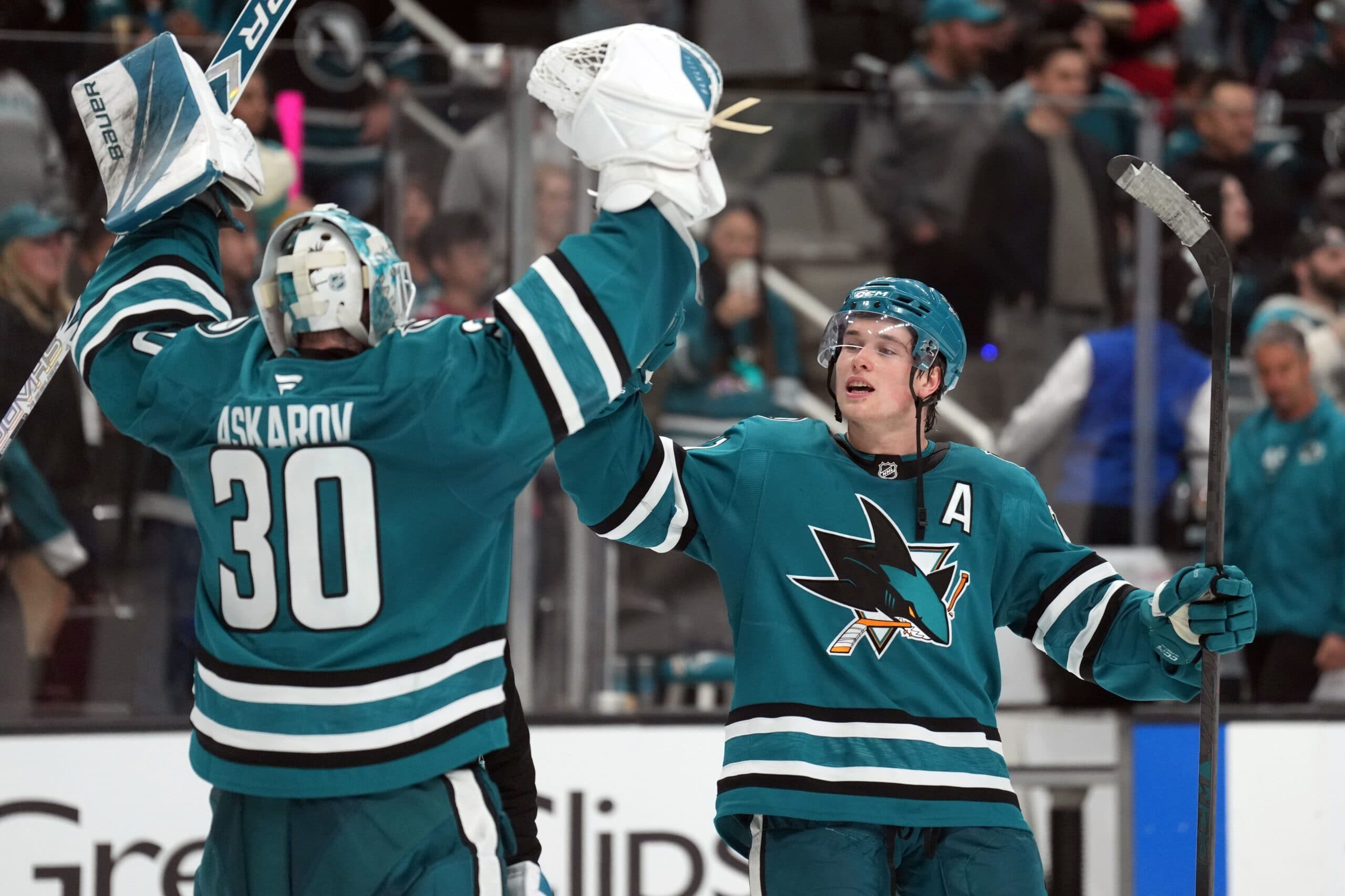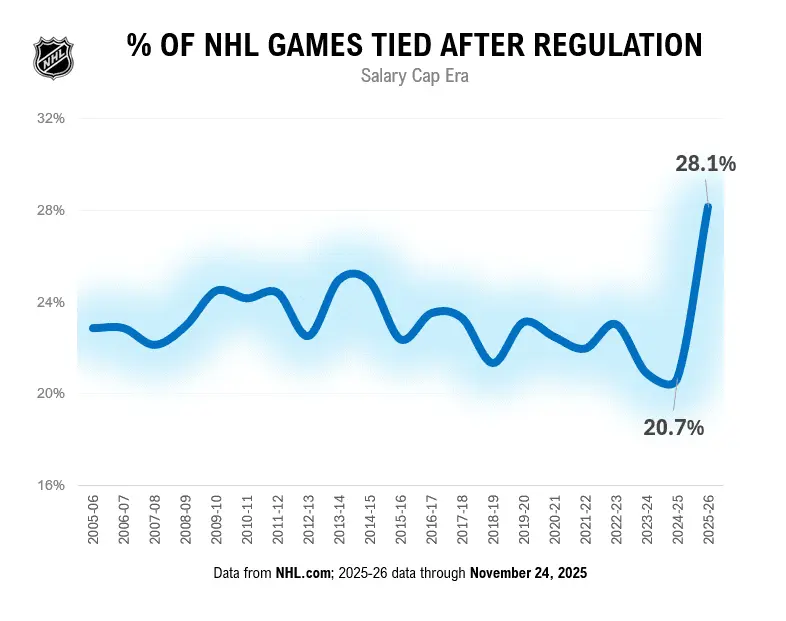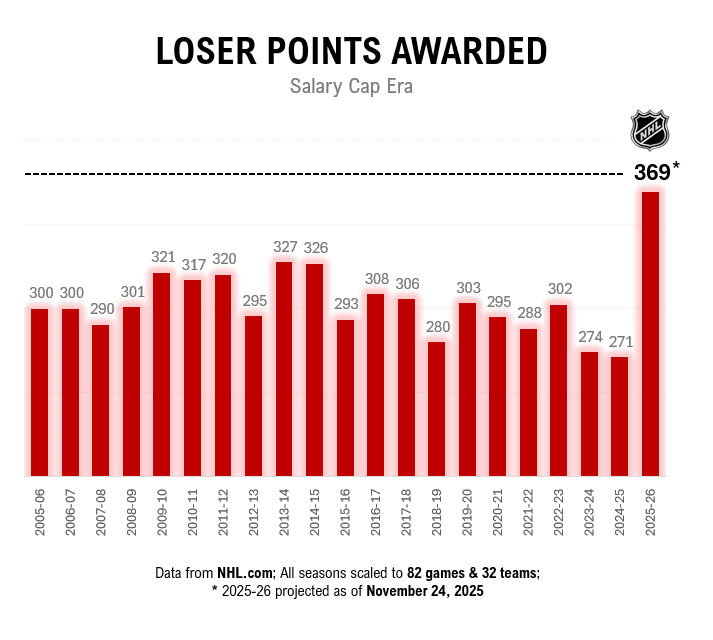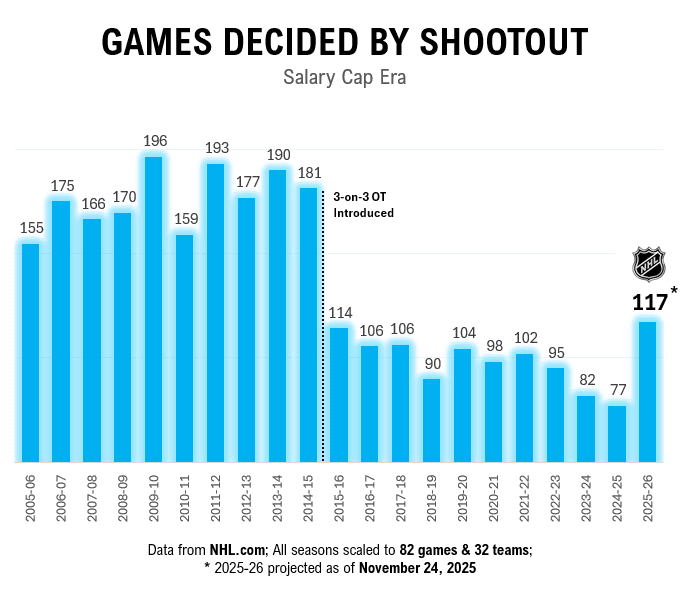Overtime, loser points unleashing chaos in NHL’s Season of Parity

It’s The Season of Parity™️ in the NHL.
Seven weeks into the schedule, the standings are jammed. Sixty minutes of regulation isn’t deciding hockey games. Teams expected to be Stanley Cup contenders are mostly indistinguishable from franchises thought to be rebuilding. And losing has never been rewarded with such frequency.
A year ago, we explored the rising influence of empty net goals on the NHL. This season’s big early trend? It’s all about three-point games — the gimmicky sweepstakes that punish good teams and disincentivize winning games tied late in regulation. The situation has led to pure chaos in the standings.
We’re diving into the extreme volume of close games and highlighting the major impact this trend is having on the league. Pardon the pun, but we’re working overtime today…
📈 The Trend
These days, if you go away for the weekend and don’t check the NHL standings, you might be in for a shock on Sunday night. Your favorite team can go from the division lead to outside a playoff spot in just a few sleeps. The tight standings are a symptom of an unusual phenomenon playing out in the season’s first quarter.
Check out the graphic below.

Regulation ties had been trickling downward for a decade. Why? With many franchises entered into long, painful rebuilds and expansion providing scoring boosts, fewer games needed extra time. Just last season, the NHL had its lowest share (20.7%) of games tied after regulation in the salary cap era. Fast forward to 2025-26 and the trend is off the rails — a cap-era high of 28.1%.
Compared to last season, a fan at an NHL game is over 35% more likely to see overtime right now.
💡 The Takeaways
#1. The NHL is on pace for a record 369 loser points — 98 more than last season.
The standings right now are absolutely flooded with extra points. The visual is stunning.

Now, it’s still early. Both underachieving and overachieving teams will see some regression. General managers will make decisions to help their current or future rosters over the course of a long season, which reduces parity. So, we should see the overtime game count slip back a little.
But look at that humungous leap in projected loser points — that’s an average of 11.5 per team.
You may be thinking: Why does it matter? … the better teams will just win more in overtime or shootouts. Bump each team’s point total up a few points on last year. No big deal, right? Not quite. We have to remember a few things about what makes three-point games so illogical in the first place:
- Overtime and shootout results are mostly random. Not completely random. Some teams — the star-driven Edmonton Oilers, for example — have an established ability to win in overtime. A few others thrive or struggle in overtime or shootouts. But the results beyond regulation year-over-year are extremely low on repeatability. The Toronto Maple Leafs‘ overtime records the last three seasons show the arbitrary nature of overtime: 8-8, 10-2, and 3-3 to date. Ultimately, NHL teams are being rewarded for winning glorified skills competitions equally to winning 6-1 in regulation. Which leads us to…
- Three-point games punish good teams. Good teams win in regulation more often, doing so without extra-time gimmicks forcing a winner. So, just win in regulation and stop complaining, right? Therein lies the problem. Consider a random Saturday a couple of weekends ago. Division rivals Buffalo and Detroit played a three-point shootout game. As did the New York Rangers and Columbus. That’s six points — the equivalent of three regulation games — that enter the Eastern Conference. Tampa Bay, meanwhile, beats Florida 3-1 yet their win is diluted. Because other games went to extra time, the Lightning’s regulation win somehow became less impactful in the standings. Make it make sense.
If you follow a mediocre team on the playoff bubble, it’s the right year to feast on the randomness of overtime and shootouts to decide playoff spots.
#2. With so many overtime games, there’s confusion on which teams are actually good.
It needs to be said that the only standings that matter are the actual standings as found on NHL.com.
But we’ve established that its a flawed system, the distortion further emphasized this season from the increase in three-point contests. If we know extra-time formats are dangerously close to a coin toss, then how can we tell which teams are ‘earning’ their points? Well, if overtime and shootout results aren’t generally repeatable, then regulation tells us a lot…

The revised standings above shine light on the teams winning in regulation, while exposing the teams preying on three-point games. Teams like Edmonton (5 regulation wins in 25 games!), San Jose (5 in 23), Philadelphia (5 in 21), Columbus (6 in 23), and Montreal (6 in 21) are in the playoff hunt despite rarely controlling games. Los Angeles (7-6-10 in regulation) is a point back of the Pacific Division lead. So many teams are barely surviving regulation yet they’ve been rewarded with empty-calorie points this year.
Boston and Pittsburgh‘s regulation results illustrate the inequity. The Bruins are 5-0 after regulation, while the Penguins are 0-5. That’s a 10-point swing using formats the NHL would never allow a playoff game to touch with a 10-foot hockey stick. Boston is 8-11-5 in regulation and Pittsburgh is 10-6-5, but the Bruins are banking the available points from the extra-time roll of the dice.
A quarter through the season, all but a handful of teams are a hot week from a playoff spot. There’s a huge incentive right now to just hang around a game as winning in regulation — outside of rare postseason tiebreaker scenarios — isn’t rewarded.
#3. The approach to scoring in overtime has been completely overhauled.
One of the most fascinating elements of 3-on-3 overtime over the years has been the increasing patience of the players. What started a decade ago as a track meet has morphed into a chess match to create a quality scoring chance. Your youth coaching shouting, “Get pucks on net!” has been replaced with, “Get only high-percentage scoring opportunities on net!“
Doesn’t quite roll off the tongue the same way… but it’s working.
This tactical shift is the biggest reason for the decline in save percentage. Goalies are bigger, faster and better than ever. But players are coached to shoot only with some combination of pre-shot puck movement, traffic, or close proximity to the net. Shots from distance or without bodies in front are simply not taken today — there’s no point.
Overtime, therefore, is a microcosm of the NHL as a whole right now. 3-on-3 play illustrates the exaggerated version of the league-wide change in approach over the last few years.
3-on-3 Game Data, by Season
| Season | Shots/60 | Goals/60 | Save % | OT Goal % |
| 2021-22 | 38.2 | 6.07 | .841 | 64.6 % |
| 2022-23 | 37.1 | 6.32 | .830 | 68.5 % |
| 2023-24 | 34.6 | 6.62 | .809 | 70.1 % |
| 2024-25 | 33.5 | 6.55 | .804 | 71.6 % |
| 2025-26* | 31.2 | 6.65 | .787 | 68.9 % |
*Through November 21, 2025; 3-on-3 data from Evolving-Hockey
Since 2021-22 — just four seasons ago — we’ve seen the following cosmic shifts in 3-on-3 play:
- Seven fewer shots per 60 minutes;
- 0.58 more goals scored per 60 minutes;
- An incomprehensible .054 drop in save percentage.
Despite teams being way more selective and scoring more efficiently, we aren’t seeing more games settled in overtime so far this season (68.9%). Teams hold onto pucks as long as possible to create a perfect play. A higher percentage of shots become goals but it leads to less action — there are fewer attempts.
There’s another unintended consequence of all of this overtime…
#4. The shootout is returning to relevance.
Just last year, I was writing the shootout’s obituary. It was fun for a long time. The shootout was the quirky but lovable uncle that the NHL leaned on in tough times post-lockout. He was cool in 2005 but he’s still wearing that chunky silver chain and aggressively texting you Spotify links to Sum 41. Times change…
In 2015, the NHL made its first move to bludgeon the shootout by moving from 4-on-4 to 3-on-3 overtime. The strategy worked wonders to the point there were only 77 shootouts last season — the least ever in a full schedule. But what’s that? I think I hear the shootout’s music… it’s creeping back.

Overtime is still deciding games at a similar rate. So, shootouts are only needed around 30% of the time. But a symptom of all of these overtime games is that shootouts are inevitably trending toward an 11-year high — the most since overtime dropped to three skaters per side.
And since shootouts are shorter and even less like real hockey, their role in deciding playoff spots feels even lamer. The shootout’s shuffle toward extinction was a blessing, but as long as more parity is leading to more overtime, reports of the shootout’s demise are greatly exaggerated.
#5. All this overtime quietly impacts the league in other areas.
While more overtime games — and the related three-point game mayhem — allows more marketing departments to stay relevant deeper into the season, there are other symptoms.
For one, the distance from .500 being “average ” is moving even further from reality. The concept or reference to .500 has long been the most irrelevant phrase in hockey. An average NHL team has a .570 points percentage right now. With so many points issued, only FIVE out of 32 teams are below .500. A team below fake .500 is effectively a lottery team.
This is, of course, the issue with loser points & the illusion of ".500" as average in the NHL.
💥True .500 this season is actually **.568**
That's the real benchmark as to how your favourite team is performing relative to league average right now. https://t.co/lvbY7crRp5
Another understated implication of 3-on-3 overtime is more superstar time on the ice. As exciting as it is to watch the world’s best wheel and deal on open ice, it’s also more wear and tear. More overtime involves more tired athletes being called upon late in games. They’ve already played big minutes in a tight game. But they’re getting sent out to play back-and-forth hockey with explosive moves, turnovers, back checks, and high-speed drives to the net.
Great for the product, but not great for superstar health in an Olympic year come April, May, and June. With so few teams assured playoff spots from so many three-point games, teams are likely to clinch later this year. This will mean it will be harder to manage ice time down the stretch.
Let’s check in with Connor McDavid.
He’s averaging 23:11 per night, most in the NHL. A career-high in ice time? In his 11th season? As he approaches his 29th birthday? Yes, the Oilers have had some injuries as top-six forwards Ryan Nugent-Hopkins and Zach Hyman have missed action. But the real culprit is the 10 overtime games that Edmonton has already played, tied for most in the NHL. That’s as many overtime games as Carolina played the entire 2024-25 season. It’s a 33-overtime pace. While it’s highly unlikely the Oilers play 30-plus overtimes, McDavid and his best teammates — fresh off two Stanley Cup Final runs — are getting worn out early and often.
Despite the peak in ice time and favorable overtime scoring deployment, McDavid has some of his lowest goal, point, and shot rates since he was a teenager.
💭 Closing Thoughts
While the NHL is licking its chops over the competitive balance, it’s hard to identify the trend as anything more than a transitionary period. The salary cap and floor chasm is its widest ever in dollars. What we’re seeing is several franchises stuck in long, painful rebuilds (i.e., Anaheim, Chicago, Detroit, San Jose) having respectable starts to the season, while some established contenders (Edmonton, Florida, Toronto, Winnipeg) have been slow out of the gate. It’s not from fundamental changes to the system promoting parity, but rather a gradual shift in power based on franchise life cycles. We’re ‘between’ organizational tanks, if you will.
Close games and overtime are fun. They keep us invested until the end of the night. They produce game-breaking moments. They allow more teams to the postseason mix. These elements of the NHL’s overtime trend are irrefutably great for hockey. But there are other subtle implications: an increased reliance on gimmicky tiebreakers to settle games; a record numbers of points for losing; the biggest devaluation of regulation wins in history; more 3-on-3 overtime featuring fewer and fewer shots on goal; the shootout’s revival; and wearing out top players from heavy overtime minutes late in games.
All of these less desirable symptoms tell us that restoring .500 hockey is long overdue. The PWHL and international hockey method of having regulation wins worth three points, extra-time wins worth two points, and extra-time losses worth one point is the logical pivot. Prioritize winning in regulation.
As for this season? Despite the inequity of the status quo, the evolution and impact of The Season of Parity has and will continue to be captivating while it lasts.
Data from Hockey-Reference; NHL.com
Recently by Paul Pidutti
- Projecting the 2026 Hall of Fame Class: Bergeron, Price and endless possibilities
- Hall of Fame tiers: Which NHL stars are destined for immortality?
- Fall Frauds: Which NHL franchises fool their fans the most?
- Believe it or not, Auston Matthews can still be Alex Ovechkin
- Goodbye, goals? Searching for a fix to the NHL’s falling scoring rates
_____
POST SPONSORED BY bet365